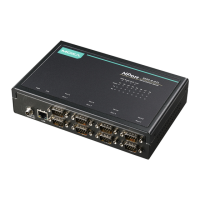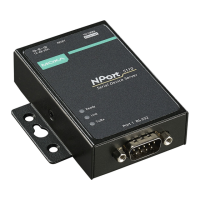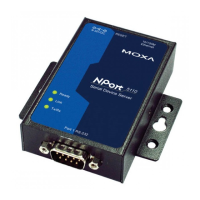NPort 5600-8-DT/DTL Series Basic Installation
STEP 4: Configure serial communication
parameters
This step covers the configuration of each device port’s serial communication parameters, such as baudrate,
stop bit, etc.
This step requires the following items:
• NPort 5600-8-DT/DTL device server with live connection to the network
• Windows PC with live connection to the same network and NPort Administrator installed
Make sure that NPort Administrator is open with your device server listed in the configuration pane. You should
also know the serial communication parameters for the attached device and intended application.
Review Serial Parameters
The following parameters need to be set correctly on the device port for proper communication with your device.
Please refer to your device’s documentation for the appropriate settings.
Parameter Options Description
Baudrate 50 bps
115.2 Kbps (default)
921 Kbps
This is the rate of data transmission to and from the
attached serial device.
Data bits 5
6
7
8 (default)
This is the size of each data character.
Stop bits 1 (default)
1.5
This is the size of the stop character.
Parity None (default)
Even
Odd
Space
Mark
This is the kind of parity that will be used. Even and
Odd parity provide rudimentary error-checking; Space
and Mark parity are rarely used.
Flow control None
RTS/CTS (default)
DTR/DSR Xon/Xoff
This is the method used to suspend and resume data
transmission to ensure that data is not lost. RTS/CTS
(hardware) flow control is recommended if possible.
FIFO Enable (default)
Disable
This controls whether the device port’s built-in
128-byte FIFO buffer is used. When enabled, the FIFO
helps reduce data loss regardless of direction.
Interface RS-232 (default)
RS-422
RS-485-2W
This is the serial interface that will be used. The
options that are available depend on the specific model
of device server.
Adjust Serial Parameters
The serial communication parameters for each device port can be configured through NPort Administrator.
Open your device server’s configuration window using the same method when you adjusted the network
parameters. On the “Serial” tab, click “Modify” and select the device port that you wish to configure. Click
“Settings” to configure the selected device port.

